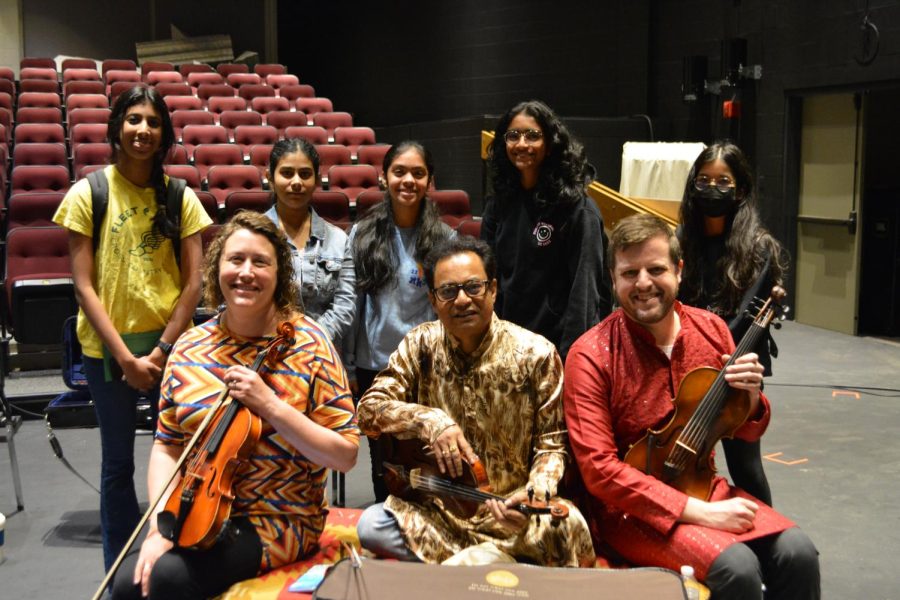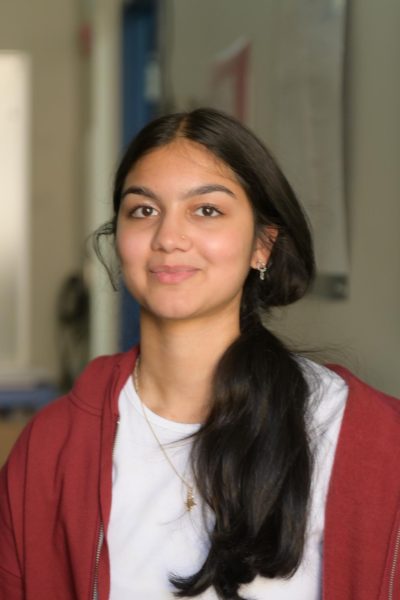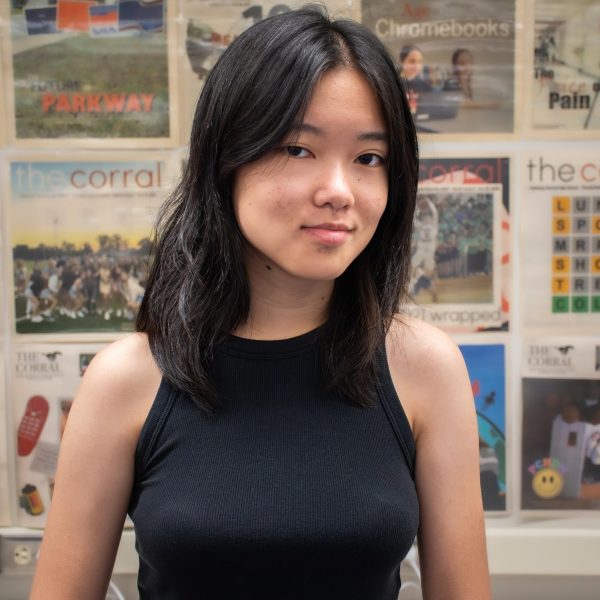A Musical Journey To India
Orchestra Director, Alicia Bont and orchestra students meet with Violision ensemble members, Rupam Ghosh and Matt Pickart after an interactive workshop in Indian Classical Music.
May 12, 2023
On May the 4th, the audience of Orchestra’s spring concert was treated to a musical trip around the globe. This was a special concert held by Orchestra in order to celebrate dances from all over the world. This ranged from Irish jigs, to Argentinian tangos, and even Indian dance styles. The preparation that had led to this multicultural event actually started way back in the fall of 2022. At the time, Alicia Bont, Orchestra Director, had been searching for a way to expose her students to the diversity within music.
“Each type of music has a whole different way of expressing feelings and like a whole different type of sound color system,” Bont said. “ . . . And there’s just so much wonderful music that’s at our fingertips right now. But, it’s hard to sift through to find what’s actually good.”
For this reason, Bont always made sure to introduce her students to a new type of music that they were previously unfamiliar with every year. This year, the music of choice was Indian classical music.
“Part of my job is to choose things that are important throughout music history and expose the kids through performance and listening to those styles and Indian music was one of them,” she said.
Later in January, during the Missouri Music Educators Association convention, Bont connected with Matt Pickart, professional musician and teacher at Webster University. Bont shared her ideas of sharing Indian music to her students with Pickart, who is also a violist from the up-and-coming music group Violision. Like its name, Violision is a four piece ensemble that blends Indian classical music and Western classical music in a unique and melodic fusion.
“There’s not very many arrangements of Indian classical music for the Western orchestra. So, I have been looking for several years to do something like this,” Bont said.
Pickart, having conducted numerous musical workshops with high school students in the past, offered to conduct an Indian classical music workshop along with the violinist of Violision, Rupam Ghosh.
“When I mentioned that Rupam Ghosh was coming, she (Bont) jumped at the opportunity for him to work with the students,” Pickart said.
Thus, an interactive introduction to Indian classical music workshop was arranged for the orchestra students on April 14. The masterclass was especially enlightening for the students who had no prior experience of Indian classical music.
“I thought that I would feel super stressed out about it, because I don’t love learning new things that I’m not immediately good at yet, but it was actually super calming,” freshman Macey Heimburger said. “It was so weird. I felt so calm during that masterclass.”
“It was my first experience playing traditional Indian music,” sophomore Kathryn Ho said. “It was really fun.”
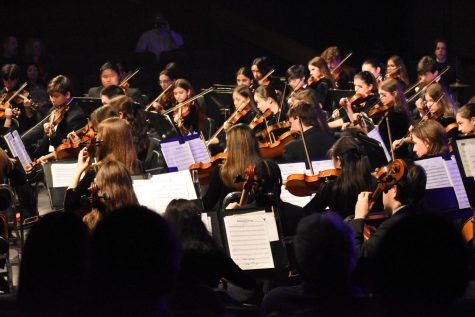
The masterclass involved the practice of imparting knowledge verbally rather than through written form, a common tradition in Indian classical arts. This however, is different from what students normally learn in orchestra.
“Most of our time is spent learning things by reading music,” Bont said. “So, it’s really important to me that, every year we should have something that we do, that’s really developing their ear.”
Ghosh, who led the session, enjoyed seeing how well the students were able to adapt to the new music style.
“It was a really great experience for me,” Ghosh said. “The students were so talented and intelligent. They have really great musical ears.”
Freshman Deepshikha Banerjee, a Kathak (North Indian dance) dancer, believes that the differences between the two music styles lie not only with the instruments but the arrangement of the music.
“I think Indian classical music is very raw to a degree,” Banerjee said. “Like, if you listen to Western classical music, it’s layer on layer on layer, . . . If it’s Indian classical music, you have the baseline, you have a rhythm, and you have the melody . . . So, I think it’s a lot more pure in a sense.”
In order to incorporate Indian classical music in their spring concert, Orchestra began practicing the piece they learnt from Rupam Ghosh for the concert. Aside from Rupam Ghosh’s composition, the orchestra began practicing a rendition of ‘Bollywood Strings’ for the concert, a piece that Sophomore Radhika Sinha believes works well for diverse audiences.
“I think when people think of Indian music, or dance or entertainment, they immediately go to Bollywood and this (Bollywood Strings) was written by a Western composer. So, it’s trying to bridge the gap between Western and Indian people,” Sinha said.
However, the concert wasn’t all about music. Banerjee, junior Tarini Karnati and freshman Krishne Sundaram prepared an intricately choreographed Indian dance portion for the rendition of ‘Bollywood strings.’
Karnati is not only well versed in a South Indian vocal style known as Carnatic music, but she does Bharatanatyam, a South Indian dance form.
“I’ve choreographed so many dances before, whether it be Bollywood, Tollywood, or even Bharatanatyam,” Karnati said. “But this is the first time I’m doing Bharatanatyam to something that is a lot different from regular Bharatanatyam music.”
Following many orchestra and dance rehearsals, the day of the concert finally came. The audience members nodded their heads to the tango music and jig pieces that the orchestra played. Additionally, on the occasion of May the fourth, the Orchestra played a score from the Star Wars soundtrack.
Following a profound message about the spiritual nature of Indian music from Bont, the orchestra commenced their soulful rendition of Rupam Ghosh’s composition. Following this, hushed murmurs of excitement rippled through the audience as they saw the dancers mount the side stages for their dance to ‘Bollywood Strings’.
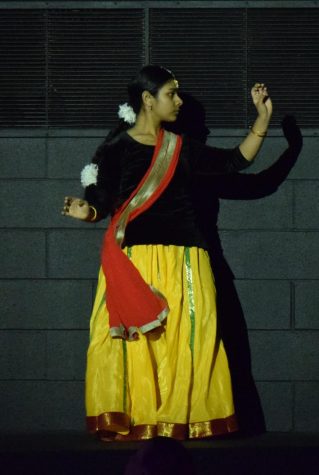
“I didn’t think I would be doing something like this for school, so it was still surreal until I got on the stage,” Banerjee said. “But, it was a great experience overall.”
Cameras flashed back and forth between the different dancers and musicians. The audience was extremely entertained by the simultaneous music and dance that they were witnessing.
“I think people really enjoyed it. Because it’s not everyday that you get to see something like that,” Karnati said.
Banerjee hopes that the concert not only entertained the audience but taught them something new.
“I hope that people are more accustomed, in a sense, and adaptable to listening to different types of music, especially since the concert was about different dances from around the world, “ she said.
Rupam Ghosh believes that the connections between musical cultures are important to maintain for the future generations.
“While witnessing the present worldwide violence and aggression, I feel that the present generation desperately seeks spiritual emancipation which can be fulfilled by Indian classical music,” Ghosh said. “Mixing musical cultures will create music for peace.”

